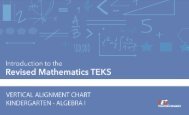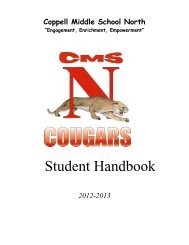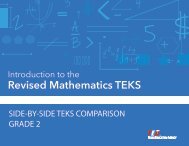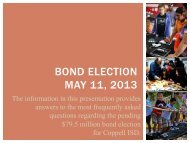SIDE-BY-SIDE TEKS COMPARISON GRADE 3 - Project Share
SIDE-BY-SIDE TEKS COMPARISON GRADE 3 - Project Share
SIDE-BY-SIDE TEKS COMPARISON GRADE 3 - Project Share
Create successful ePaper yourself
Turn your PDF publications into a flip-book with our unique Google optimized e-Paper software.
Grade 3 – Mathematics+Current <strong>TEKS</strong>: Number, Operation, andQuantitatifve Reasoning3(2)(B) Number, operation, andquantitative reasoning. The student usesfraction names and symbols (withdenominators of 12 or less) to describefractional parts of whole objects or sets ofobjectsThe student is expected to comparefractional parts of whole objects or setsof objects in a problem situation usingconcrete models.Revised <strong>TEKS</strong> (2012) Supporting Information Notes3(3)(H) Number and operations.Thestudent applies mathematical processstandards to represent and explain fractionalunits.The student is expected to compare twofractions having the same numerator ordenominator in problems by reasoningabout their sizes and justifying theconclusion using symbols, words,objects, and pictorial models.The revised SE adds specificity to the numberof fractions a student compares. It also addsspecificity to the types of fractions beingcompared: two fractions having the samenumerator or denominator.Fractions should have denominators of 2, 3,4, 6, or 8.Examples include situations such ascomparing the size of one piece when sharinga candy bar equally among four people orequally among three people.Students justify conclusions using objects.Students justify conclusions about theircomparisons using symbols, words, andpictorial models.+3(2)(C) Number, operation, andquantitative reasoning. The student usesfraction names and symbols (withdenominators of 12 or less) to describefractional parts of whole objects or sets ofobjects.The student is expected to use fractionnames and symbols to describe fractionalparts of whole objects or sets of objects.3(3)(C) Number and operations.Thestudent applies mathematical processstandards to represent and explain fractionalunits.The student is expected to explain thatthe unit fraction 1/b represents thequantity formed by one part of a wholethat has been partitioned into b equalparts where b is a non-zero wholenumber.3(3)(D) Number and operations.Thestudent applies mathematical processstandards to represent and explain fractionalunits.The student is expected to compose anddecompose a fraction a/b with anumerator greater than zero and lessthan or equal to b as a sum of parts 1/b.The current SE was separated into threerevised SEs. Revised SE 3(3)(C) focuses onunit fractions.Specificity has been added to the descriptionsstudents are expected to provide withsymbols for writing fractions.Fractions should have denominators of 2, 3,4, 6, or 8.Students are expected to describe or explainthe fraction 1/b as the quantity formed byone part of a whole that has been partitionedinto b equal parts where b is a non-zerowhole number.A fraction may a part of a whole object orpart of a set of objects.The current SE was separated into threerevised SEs. Revised SE 3(3)(D) focuses onnon-unit fractions.Fractions should have denominators of 2, 3,4, 6, or 8.Specificity has been added as to how studentsare expected to describe fractional parts ofwhole objects. Students are expected tocompose and decompose fractions. Forexample, 7/8=1/8+6/8; 7/8=2/8+5/8; and7/8=3/4+4/8.A fraction may a part of a whole object orpart of a set of objects to build to 3(3)(E).©2013 Texas Education Agency. All Rights Reserved 2013 Introduction to the Revised Mathematics <strong>TEKS</strong>: Side-by-Side <strong>TEKS</strong> Comparison 5
















